Extending Home Networks - A Comparison of G.hn, HomePlug AV2 and Wi-Fi Mesh
by Ganesh T S on December 7, 2016 8:00 AM ESTExtending Wi-Fi Reach: ARRIS SBX-AC1200P (G.hn) vs. Netgear Orbi (Mesh Wi-Fi)
In the previous section, we looked at the performance of a G.hn device compared to one of the recent HomePlug AV2 products. Both products aimed at extending a wired network. Moving on to products that aim to improve Wi-Fi reach specifically, we again take a look at another G.hn device. For comparison of the performance of a wired power line backhaul against wireless backhaul, we go for a mesh Wi-Fi system with two nodes.
With respect to the PLC segment, the SBX-AC1200P is similar to the SBX-1000P that we saw in the previous section. However, the slightly larger footprint enables the integration of a 2x2 802.11ac/b/g/n simultaneous dual-band chipset. This chipset is again Broadcom-based, similar to the SBR-AC1900P. However, the actual SoC is the BCM47189 which integrates a 2x2:2 802.11ac (5 GHz) radio along with the CPU (ARM Cortex A7) and switch. The 2.4 GHz radio duties are handled by the BCM43217 SoC. With a G.hn node at the router end, the power line can act as a backhaul for the access point present in the SBX-AC1200P. A bit of work at the firmware level in both nodes can ensure that consumers/devices see only one SSID that gains strength in the vicinity of the location of the SBX-AC1200P.
The mesh Wi-Fi system that we will be comparing against is the Netgear Orbi. As mentioned in the introduction, the Netgear Orbi router and satellite kit operates in a hub-and-spoke model. For our evaluation, we only use one router and one satellite. For most households, this configuration is more than enough to blanket the whole house with Wi-Fi coverage compared to the packs of three sold by other vendors.
The reason that the Orbi is able to get away with just one router and one satellite is due to the effectiveness of the backhaul. While most mesh Wi-Fi systems in the market use the same radio for both clients as well as backhaul (a drawback depicted in the first section), Orbi uses a dedicated backhaul radio. In addition, most mesh Wi-Fi systems are currently more concerned with the user experience and external aspects, rather than performance under load with multiple clients. While the Wi-Fi reach aspect is solved to some extent (in a manner similar to range extenders), the usage of a single 2x2 radio severely hampers performance when it is used for the backhaul too. That said, some mesh Wi-Fi systems like eero do have a second 5 GHz radio, but, that is also a 2x2 configuration. Orbi's dedicated backhaul is a 4x4 configuration, and that results in some downright impressive throughput numbers, as we shall see further down in this section.
Netgear has adopted the Qulacomm Atheros IPQ4019 as the primary network processor SoC in the Orbi. This SoC supports Wi-Fi SON, and that handles a lot of the intelligence with respect to setup and ease of use. A detailed evaluation of the features of Wi-Fi SON is beyond the scope of this article, but, readers can easily recognize that most of the features offered by mesh Wi-Fi systems can trace their origin / concept to what is provided by Wi-Fi SON.
Our benchmarks involving these two kits help in comparing the performance of wired power line backhaul and Wi-Fi backhaul with a 4x4 802.11ac connection. The graphs below shows the TCP and UDP downlink and uplink speeds across the six different locations in our test setup.
The Wi-Fi backhaul turns out to be better than the wired G.hn backhaul in every tested scenario. Despite our UDP testing script not playing well with the Wi-Fi link. we find that the powerline backhaul is no match for the 4x4 802.11ac link between the Orbi router and satellite.
At all the tested nodes, the router and the satellite were able to maintain a successful link over the 5 GHz backhaul. Netgear indicated that in extreme cases, the router and satellite could also end up communicating over the 2.4 GHz band. However, we didn't encounter that case in our testing.
The worst case TCP throughput in the Orbi case was slightly more than 600 Mbps. Under impractical 'ideal' conditions (the router and satellite being placed in adjacent rooms and just separated by a drywall), the TCP throughput came out to be close to 800 Mbps. It can also be seen that the link rate doesn't degrade much between locations, since most of them are within the same radius. That is another advantage of the wireless link strategy being adopted by the Wi-Fi mesh vendors. Mileage is bound to vary based on a number of environmental factors such as sources of Wi-Fi interferences, placement of circuit breakers etc. Therefore, it is important to note that our comments on the performance are based on results from the testing done in a Wi-Fi-friendly building structure


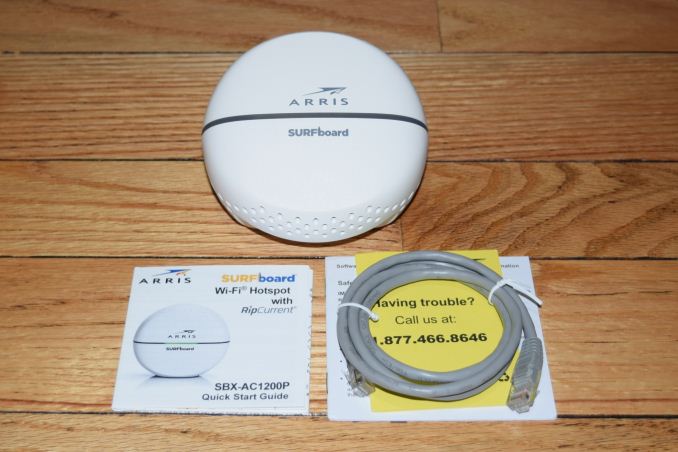
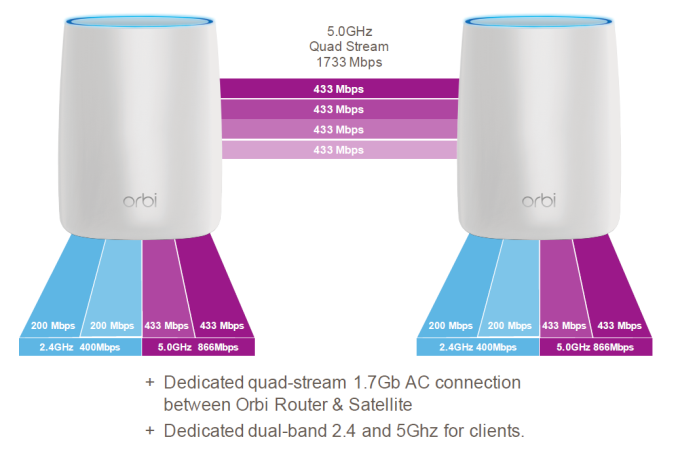
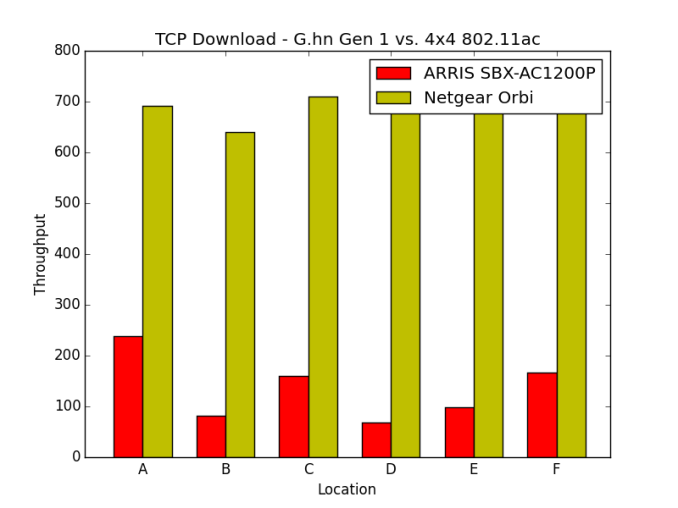
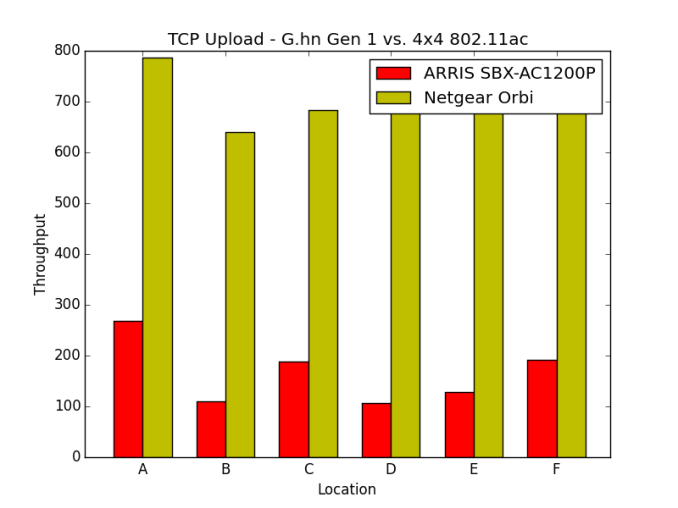
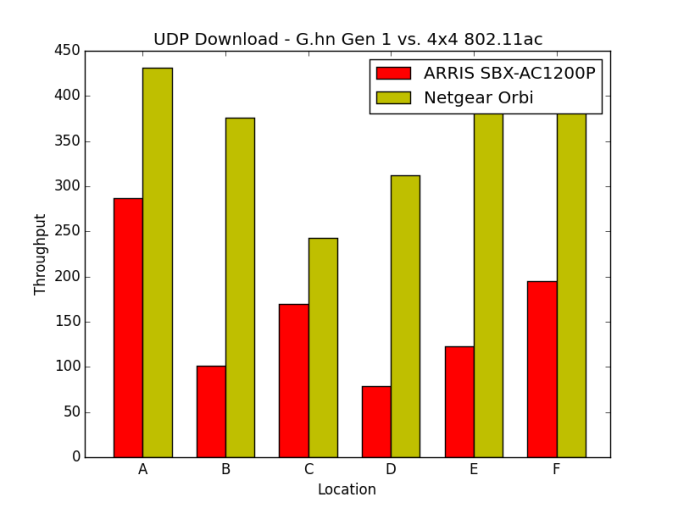









56 Comments
View All Comments
nedjinski - Wednesday, December 7, 2016 - link
Is Google's recently announced Wi-Fi / OnHub too late to be included in this article? Or is a different type of system?nedjinski - Wednesday, December 7, 2016 - link
http://www.theverge.com/2016/12/6/13843536/google-...J_D - Wednesday, December 7, 2016 - link
http://arstechnica.com/gadgets/2016/12/review-comp...Meteor2 - Tuesday, December 13, 2016 - link
Thanks for those links; good reviews. Orbi boasts best performance, but Google WiFi clearly wins with good design and user experience, and adequate performance.Sailor23M - Saturday, December 10, 2016 - link
Problem with getting a google system is that I suspect that it will "phone home" on everything I do on the internet.iamlilysdad - Wednesday, December 7, 2016 - link
The benchmarks processed for this article were aimed at determining the effectiveness of kits in extending the reach of the home networks. Therefore, it was an evaluation of the backhaul, rather than performance with client devices themselves.^^^ Is there an upcoming article that addresses real world performance and use for client devices? Seems that is ultimately what needs to be measured since that is the entire user experience. I don't care about backhaul capability if the device fails to provide adequate performance to the devices that I connect to it.
melgross - Wednesday, December 7, 2016 - link
This is all very nice, but that house is very easy to do. Older houses are much more difficult.My house was built in 1925. It's two floors. The ceilings are wood lath, with steel mesh holding 3/4 inch mortar with 1/4 inch plaster with numerous layers of paint, the older layers are lead based (well contained). The walls are mostly brick with the above lath, etc. This is very difficult.
While most of the house was wired by myself years ago with CAT 5e, there's a problem. For some reason, my FIOS router doesn't allow (though the instructions says it does, word out is that it's buggy) multiple Ethernet connections for the extenders, for wifi, though Ethernet works just fine, even when I do exactly what the manual says to do. So I tried to use the extenders through my main Apple router, but no go. More than one wifi router wired directly, or through the main apple unit turn the internet signal off at the gateway. Weird! This all worked perfectly with the old gateway with COVAD, so I don't think it's anything I'm doing wrongly.
Because of this, I'm forced to use 4 Apple routers around the house, and I get 155/155 near the main router and with the one in the living room, but then it falls to 30/30, and even lower to below 20/20. Since FIOS is 150/150, or a bit higher, it's frustrating.
So the question here is not how well these do in cheaply built 70's bousing, but in older housing that much less easy for signal throughput. We really need these things tested under more serious conditions.
BrokenCrayons - Wednesday, December 7, 2016 - link
Your home situation sort of started me thinking. One older home I lived in had a wood burning stove as its primary heat source. It was part of the original design, but an oil burning forced air furnace was later added. In any event, in the original design, several grated holes were placed in the ceiling of the first floor to ensure heat from the stove would reach the second floor.You could do something similar with your home by cutting open the floors and the walls to install wireless friendly passages that help signals travel more freely. If I was on anything faster than a 12mbps down and 768kbps up DSL link, I'd seriously consider doing the same because there's nothing worse than having a downstream connection that's faster than your local network. A few window-sized holes in the right walls and floors could vastly improve your situation.
melgross - Wednesday, December 7, 2016 - link
Yes. That's very funny. Cutting windows sized holes throughout the house would add to air flow as well.BrokenCrayons - Thursday, December 8, 2016 - link
I'm not suggesting you just grab some tools and start chopping. To retain house value, you probably should ensure the job is done professionally and the holes are dressed to look appealing to the eye. In my mind, fast network access is worth the trouble of doing some modifications. Besides, the wireless-friendly nature of your home after modifications are completed will probably drive up its resale value to potential buyers that are upset about the same problems your're experiencing now.The other alternative, depending on your financial situation, is just to unload that house on the market and move into newer construction that can handle modern needs. Though older homes have a certain rustic and quaint appeal, we really should be demolishing buildings made before lead regulations were put in place to get rid of those unsightly old structures. Modern houses are a lot more energy efficient anyway and it's really irresponsible for us to keep anything that was built before the 1990s up and working. Such places are ultimatly wasteful and unfit for human habitation due to a variety of health hazards introduced during their construction.